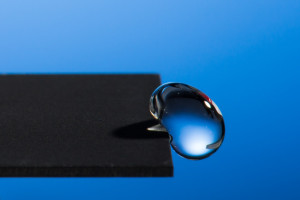 A laser-etching technique that creates a super hydrophobic sheet of metal was developed by scientists at the University of Rochester. It’s hydrophobic to the point that water doesn’t just move off to one side when tilted at an angle. Water drops really bounce off frequently until they either drop off the edge.
A laser-etching technique that creates a super hydrophobic sheet of metal was developed by scientists at the University of Rochester. It’s hydrophobic to the point that water doesn’t just move off to one side when tilted at an angle. Water drops really bounce off frequently until they either drop off the edge.
Super-hydrophobic materials are needed in a number of applications such as rust prevention, anti-icing, or even in sanitation uses. However, as Rochester’s Chunlei Guo explains, most current hydrophobic materials rely on chemical coatings.
In a paper published today in Journal of Applied Physics, Guo describes a powerful and precise laser-patterning technique that creates an intricate pattern of micro- and nanoscale structures to give the metals their new properties. This work builds on earlier research by the team in which they used a similar laser-patterning technique that turned metals black. Guo states that using this technique they can create multifunctional surfaces that are not only super-hydrophobic but also highly-absorbent optically.
Guo adds that one of the big advantages of his team’s process is that “the structures created by our laser on the metals are intrinsically part of the material surface.” That means they won’t rub off. And it is these patterns that make the metals repel water. “The material is so strongly water-repellent, the water actually gets bounced off. Then it lands on the surface again, gets bounced off again, and then it will just roll off from the surface”. That whole process takes less than a second.
As the water bounces off the super-hydrophobic surfaces, it also collects dust particles and takes them along for the ride. To test this self-cleaning property, Guo and his team took ordinary dust from a vacuum cleaner and dumped it onto the treated surface. Roughly half of the dust particles were removed with just three drops of water. It took only a dozen drops to leave the surface spotless. Better yet, it remains completely dry.
Guo is keen to stress that this same technique can give rise to multifunctional metals. Metals are naturally excellent reflectors of light. That’s why they appear to have a shiny luster. Turning them black can therefore make them very efficient at absorbing light. The combination of light-absorbing properties with making metals water repellent could lead to more efficient solar absorbers — solar absorbers that don’t rust and do not need much cleaning.
Guo’s team is now planning on focusing on increasing the speed of patterning the surfaces with the laser, as well as studying how to expand this technique to other materials such as semiconductors or dielectrics, opening up the possibility of water repellent electronics.
Funding was provided by the Bill & Melinda Gates Foundation and the United States Air Force Office of Scientific Research.



